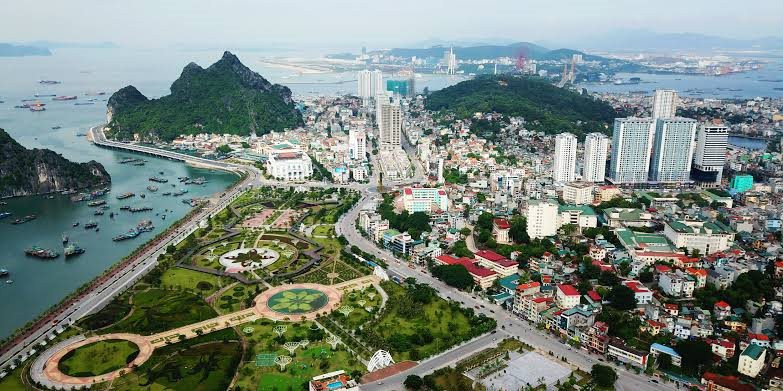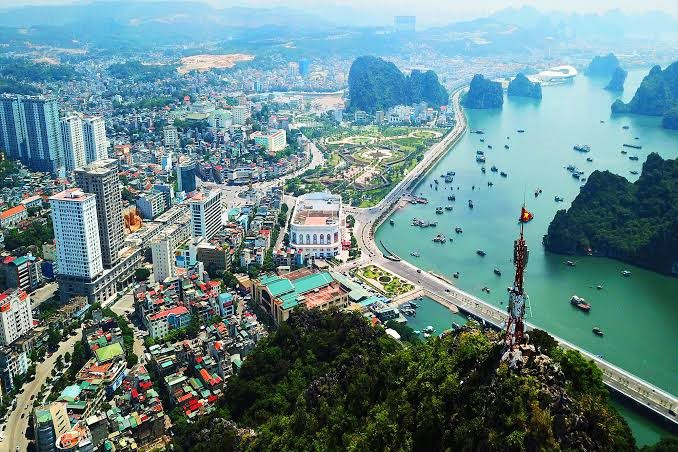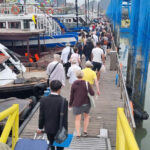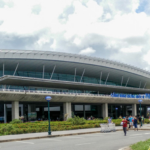
For the period 2021-2030, Quang Ninh province is focusing its resources on investing in the development of the Quang Ninh urban system to become a modern, eco-friendly, and civilized city.
The adoption of the province’s Urban Development Program up to 2030 is a prerequisite for concentrating all investment resources to soon build and plan Quang Ninh to become a centrally-controlled city before 2030, while also contributing to improving people’s income, according to the Quang Ninh provincial website.

Quang Ninh aims to become a centrally-controlled city before 2030.
According to the Quang Ninh Provincial Urban Development Program up to 2030, Quang Ninh will strive to become a centrally-controlled city with a unique model, in which, instead of forming districts, an inner-city area will be established, comprising cities within the city, connected by advanced technical infrastructure such as urban public transport systems and information and communication infrastructure.
These inner-city areas include Ha Long, Quang Yen, Uong Bi, Dong Trieu, Cam Pha, Van Don, and Mong Cai (Hai Ha district will be merged with Mong Cai city). They will be invested in and developed to meet the standards of socio-economic and technical infrastructure quality for a first-tier city by 2030. With 152 communal-level administrative units, including 77 wards (accounting for 51% of the number of wards). Other towns in Tien Yen, Dam Ha, Binh Lieu, Ba Che, and Co To districts will continue to be invested in and completed according to Decision 241/QD-TTg of the Prime Minister.
By 2025, Quang Ninh province is expected to have 13 administrative units with 13 towns. By 2030, the province will have 12 administrative units, with a total population of about 2.64 million people (including a resident population of about 1.63 million), and an urbanization rate of over 75%.
Quang Ninh will become a centrally-controlled city by forming an inner-city area comprising 7 cities (Ha Long, Cam Pha, Uong Bi, Mong Cai – Hai Ha, Dong Trieu, Quang Yen, and Van Don) and re-establishing Tien Yen town.
At the same time, 3 inter-district regions will be formed, including: Van Don inter-district region, comprising Van Don district, Co To district, Tien Yen district, and Ba Che district. Among them, the urban center of Van Don district is the regional center, with a population of about 323,500 people and an area of about 4,145 km2.
This is a region focused on tourism, clean industry, high technology, logistics, and agriculture, with Van Don as the coastal economic zone, a breakthrough area, and a development center that enhances connectivity to the mountainous regions in the north and the island areas in the south, serving as a new gateway to the sea for the northeastern mountainous region.

The future Quang Ninh city will be built with a unique model.
The Mong Cai inter-district region includes Mong Cai city, Hai Ha district, Dam Ha district, and Binh Lieu district, with Mong Cai city associated with the Mong Cai Border Gate Economic Zone as the breakthrough area and regional center, with a population of about 418,900 people and an area of about 2,671 km2. This is a key region for developing border gate economics and border tourism, serving as a gateway for ASEAN to Northeast Asian countries, featuring high-speed roads and large-scale seaports in Hai Ha and Van Ninh.
According to the Quang Ninh News, to implement the proposed content, the province has developed a list and plan for upgrading the type of urban areas in the province by 2030, along with development orientations and proposals for development options, priority investment projects for developing the framework infrastructure system, and solutions in terms of mechanisms, policies, and implementation.
Quang Ninh Has Favorable Conditions for Economic Development
Quang Ninh is a key economic region and a driving force in the Northern Key Economic Region. Quang Ninh has many economic zones, and the Mong Cai Commercial Center is a hub for trade between Vietnam and China and other countries in the region.
Quang Ninh possesses favorable conditions for the important socio-economic development in the process of industrialization and modernization of the country.

The province has mineral resources and raw materials for construction materials production, providing equipment and raw materials for domestic production sectors and exports, making an important contribution to economic development and growth, according to the Quang Ninh Newspaper.
In the first half of 2024, Quang Ninh’s economy continued to maintain growth, with GRDP estimated at 9.02%, ranking 4th in the Red River Delta region and 8th among provinces and cities nationwide.
Specifically, the growth rate of gross regional domestic product (GRDP) in the province is estimated to increase by 9.02%, exceeding the upper limit of the growth scenario (the scenario is 9.0%), ranking 4th in the Red River Delta region and 8th in the country (GDP nationwide increased by 6.42%).
The Resurgence of Quang Ninh: A Province’s Resilience and Road to Recovery from Typhoon Yagi’s Wrath.
“A week after the typhoon made landfall, many areas from Ha Long to Van Don and Cam Pha in Quang Ninh Province were still in disarray, with debris littering the streets. However, businesses, local authorities, and various forces have joined hands to recover from this historic storm.”










































